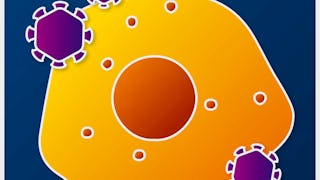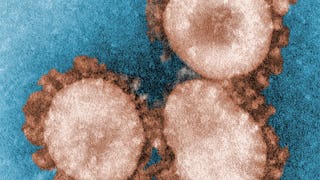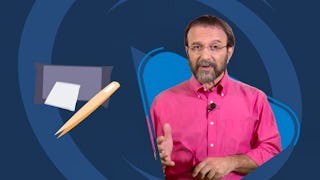This course describes the basic nature if viruses and basic concepts of how they replicate. It looks at traditional methods for propagating and assaying viruses as well as methods to identify and follow them in individuals and populations. It will also look at how we can use molecular genetics to learn how viruses work in molecular detail.

Gain next-level skills with Coursera Plus for $199 (regularly $399). Save now.

What Are Viruses And How Do We Work With Them?
This course is part of Foundations in Virology and Vaccinology Specialization

Instructor: Mike Skinner
1,782 already enrolled
Included with
(16 reviews)
Recommended experience
What you'll learn
Recognise how viruses cause infection
Recognise how vaccines prevent infections
Skills you'll gain
Details to know

Add to your LinkedIn profile
11 assignments
See how employees at top companies are mastering in-demand skills

Build your subject-matter expertise
- Learn new concepts from industry experts
- Gain a foundational understanding of a subject or tool
- Develop job-relevant skills with hands-on projects
- Earn a shareable career certificate

There are 5 modules in this course
The names of some viruses are instantly recognisable. The impact on an individual, a family, a community, and beyond, can be devastating. Disease, serious illness, and even death. Others have not been in the spotlight so much in recent years but have been incredible threats to humans and humanity. However, most recent COVID-19 pandemic, has shone a spotlight again on viruses and the fragility of our defences against, existing threats that are constantly mutating, adapting and evolving let alone against newly emerging threats. This week we look at the question: What are viruses?
What's included
6 videos5 readings2 assignments
How do viruses replicate and spread? If we want to understand the fundamental characteristics of viruses, so that we can find ways to tackle them, we need to know how viruses replicate and spread. In this module, we are going to look at virus replication and spread and introduce some terms around these concepts.
What's included
9 videos4 readings2 assignments
To be able to study viruses, we need to be able to isolate and then produce viruses using a process from horticulture called propagation. We can then use cells cultivated in mass quantities using laboratory techniques and pass the isolated virus cells through the cultivated cells to study the effects of the virus in a process called passaging. In this module, we will look at the development of propagation and passaging techniques – how these have evolved over time, and how they have impacted the development and production of vaccines.
What's included
8 videos5 readings3 assignments
There was a lot in the media about variants and mutations during the COVID-19 pandemic. We had variants named after where they were first recognised. Then they were given Greek letter identifiers, such as delta and omicron. How important is it to have an understanding of how viruses evolve, and which types of viruses are likely to evolve much quicker than others? What is the impact of mutations on antiviral drug effectiveness? And overall, how are viruses, and the diseases they cause, shaped by mutation, selection and evolution? This week, we will look at virus mutation, their types and consequences, and the evolution of novel viruses through reassortment, recombination, and adaptation.
What's included
5 videos2 readings2 assignments1 discussion prompt
Conventional virus genetics talks about the range of genotypes, range of phenotypes, stability and quasispecies. Traditional genetic analysis often involves associating observable phenotypes with genotypes, then mapping the mutations causing those genotypes. Mapping normally involves looking at the genetic linkage between known and unknown genetic markers. In this module, we will look at viral genetics - the approaches used in conventional virus genetics, and the limitations of conventional virus genetics.
What's included
6 videos3 readings2 assignments1 discussion prompt
Earn a career certificate
Add this credential to your LinkedIn profile, resume, or CV. Share it on social media and in your performance review.
Instructor

Offered by
Explore more from Basic Science
 Status: Free Trial
Status: Free TrialImperial College London
 Status: Preview
Status: PreviewUniversity of Leeds
 Status: Free
Status: FreeAmerican Museum of Natural History
 Status: Free Trial
Status: Free TrialLecturio
Why people choose Coursera for their career




Learner reviews
16 reviews
- 5 stars
87.50%
- 4 stars
6.25%
- 3 stars
6.25%
- 2 stars
0%
- 1 star
0%
Showing 3 of 16
Reviewed on Aug 6, 2024
This is a really great course. I'm really liking this specilisation as it is giving me a comprehensive overiew about both Virology as well as Vaccinology. It's a very well organised specilisation.

Open new doors with Coursera Plus
Unlimited access to 10,000+ world-class courses, hands-on projects, and job-ready certificate programs - all included in your subscription
Advance your career with an online degree
Earn a degree from world-class universities - 100% online
Join over 3,400 global companies that choose Coursera for Business
Upskill your employees to excel in the digital economy
Frequently asked questions
To access the course materials, assignments and to earn a Certificate, you will need to purchase the Certificate experience when you enroll in a course. You can try a Free Trial instead, or apply for Financial Aid. The course may offer 'Full Course, No Certificate' instead. This option lets you see all course materials, submit required assessments, and get a final grade. This also means that you will not be able to purchase a Certificate experience.
When you enroll in the course, you get access to all of the courses in the Specialization, and you earn a certificate when you complete the work. Your electronic Certificate will be added to your Accomplishments page - from there, you can print your Certificate or add it to your LinkedIn profile.
Yes. In select learning programs, you can apply for financial aid or a scholarship if you can’t afford the enrollment fee. If fin aid or scholarship is available for your learning program selection, you’ll find a link to apply on the description page.
More questions
Financial aid available,

